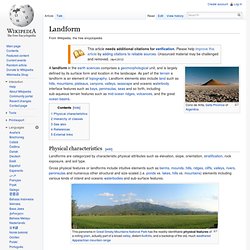

Oceans.
Landform. A landform in the earth sciences comprises a geomorphological unit, and is largely defined by its surface form and location in the landscape.

As part of the terrain a landform is an element of topography. Landform elements also include land such as hills, mountains, plateaus, canyons, valleys, seascape and oceanic waterbody interface features such as bays, peninsulas, seas and so forth, including sub-aqueous terrain features such as mid-ocean ridges, volcanoes, and the great ocean basins.
Physical characteristics[edit] Landforms are categorized by characteristic physical attributes such as elevation, slope, orientation, stratification, rock exposure, and soil type. Gross physical features or landforms include intuitive elements such as berms, mounds, hills, ridges, cliffs, valleys, rivers, peninsulas and numerous other structural and size-scaled (i.e. ponds vs. lakes, hills vs. mountains) elements including various kinds of inland and oceanic waterbodies and sub-surface features.